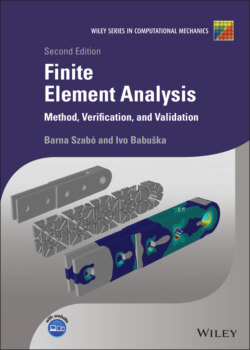Читать книгу Finite Element Analysis - Barna Szabó - Страница 22
1.3 Approximate solutions
ОглавлениеThe trial and test spaces defined in the preceding section are infinite‐dimensional, that is, they span infinitely many linearly independent functions. To find an approximate solution, we construct finite‐dimensional subspaces denoted, respectively, by , and seek the function that satisfies for all . Let us return to the introductory example described in Section 1.1 and define
where ϕi () are basis functions. Using the definitions of and given in eq. (1.12), we write the bilinear form as
(1.43)
Similarly,
(1.44)
where ri is defined in eq. (1.12). Therefore we can write in the following form:
(1.45)
Since this must hold for any choice of , it follows that
(1.46)
which is the same system of linear equations we needed to solve when minimizing the integral , see eq. (1.14). Of course, this is not a coincidence. The solution of the generalized problem: “Find such that for all ”, minimizes the error in the energy norm. See Theorem 1.4.
Theorem 1.3 The error e defined by satisfies for all . This result follows directly from
Subtracting the second equation from the first we have,
(1.47)
This equation is known as the Galerkin11 orthogonality condition.
Theorem 1.4 If satisfies for all then un minimizes the error in energy norm where is the exact solution:
(1.48)
Proof: Let and let v be an arbitrary function in . Then
The first term on the right is , the second term is zero on account of Theorem 1.3, the third term is positive for any in . Therefore is minimum.
Theorem 1.4 states that the error depends on the exact solution of the problem and the definition of the trial space .
The finite element method is a flexible and powerful method for constructing trial spaces. The basic algorithmic structure of the finite element method is outlined in the following sections.
